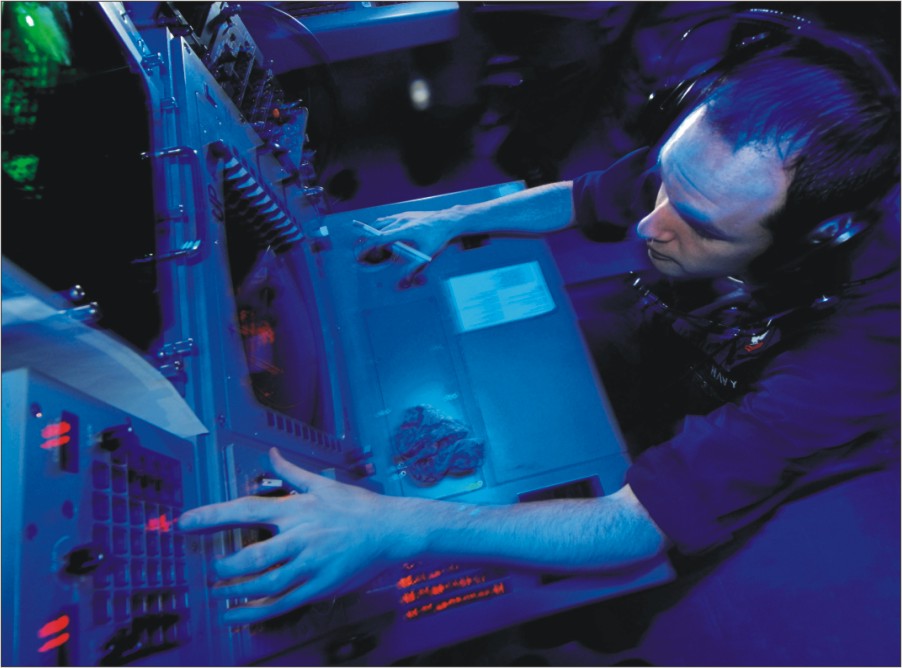Given the Indian context the thought arises whether the efficacy of the Network Centric Warfare system (NCW) depends on the existence of a Chief of Defence Staff and the absence of turf wars between the users of the system.
Concomitantly, will turf wars disappear once the CDS is operational? As things stand an indigenously developed system, by which the soldier at the forward edge of battle can be connected to the higher echelons of command for better situational awareness all up and down the theatre-wide ladder. Technologically the connectivity reaches from the soldier on the ground to the surface and space-based assets. One such bright step is-the GSAT- 7-which was launched at the end of August and will service the surveillance and reconnaissance requirements of the Indian Navy.
It is now no secret that inter-Service synergy, or rather the lack of it, has consumed the very concept of the Chief of Defence Staff so the Government and the Ministy of Defence need to be on their toes to ensure that turf wars and inter se rivalries between the top brass of the Indian Air Force, the Indian Army and the Indian Navy does not result in another fiasco like the Chinese invasion of 1962.
China is watching the Indian military behavior with great gusto and is exploiting the breakdown of command and control in a specific area in the Ladakh sector to conduct intrusions. That there are factors other than equipment and communications facilities that mould the battlefield is becoming more obvious by the day in the many Chinese pinpricks.
Impractical approach
That anything is possible can be seen in the manner in which the indigenously developed handheld tablet, that was supposed to be a crucial link in network centricity, has practically been scuttled by the age-old of the Indian armed forces affliction-changing the qualitative staff requirement (QSR) in midstride.
The SATHI (Situation Awareness and Tactical Handheld Information) equipment appears to have been ditched over the operational range which in the original specifications was 1 km and raised to 1.5 midway.
The Army now wants a long range system citing problems of communications in the mountains and jungles of Jammu and Kashmir where the prototype equipment was field tested. The Indian Army knew fully the problems in communications in the mountains gleaned from the Kargil experience when there was an attenuation of signal strength during communications across valleys and this factor should have been the benchmark for any future QSRs.
The group of persons who formulated the QSRs on the basis of which a private sector electronics company produced the SATHI and later improved upon its range from 1 km to 1.5 km need to be charged with criminal conspiracy to undermine national security by knowingly setting QSRs that were inadequate as seen from the Kargil experience.
When it was first produced the SATHI was lauded as a major achievement in network centricity. The project 2004-05 as project BETA and later renamed SATHI is a portable combat information system providing a Common Operating Picture (COP) to the infantry soldier and his team on the ground the equivalent of a section of ten.
In addition, the equipment also has the ability to connect to an external long range radio to provide the battlefield picture to senior commanders. There is an integrated Geographical Positioning System (GPS) and radio, a customized Geographical Information System (GIS), dynamic wireless LAN and user friendly battlefield application. A very important component is the Software Defined Radio (SDR) which forms the core of a network for tactical deployment on the forward edge of battle. The device communicates with frequency hopping to relay the information to HQs without being intercepted by the enemy.
It turns out that the Army placed orders for 390 pieces with the provision that 30 production models be first supplied for field testing up to the brigade level of the network (the 390 were intended to serve the needs of one whole Corps deployed in Jammu and Kashmir).
It was then that the range problem was brought up and the project scuttled. If one were to ask about the Network Centric Warfare capability of the Indian Army in a crucial sector of its operations one would have to admit that it is not optimal. This is because the first link in the centricity-the foot soldier in the field is still using the old walkie-talkie for communications.
SATHI’s claim to fame was based on the following applications: it can be used in collaboration with hand held thermal imagers (HHTI), night vision devices (NVDs), unattended ground sensors (UGS) and radios, which could be very effective in counter insurgency and border management operations to provide real time common information and strengthen the surveillance grid.
The Army which is in the throes of modernization with the inclusion of UAVs, rotary wing assets and satellite communication, SATHI will increasingly become essential elements of the coordinated close battle.
Given what has been happening along the Line of Control as well as the Line of Actual Control where Indian soldiers have been ambushed in their own territory and Chinese have made deep inroads in the Depsang Valley area, it is clear that none of the facilities touted for the SATHI are in operation.
Tactical communication
Among the key elements in the Network Centric Warfare system is the Tactical Communications Systems and in this area too India is slowed down by the absence of progress in what is essentially an indigenous response to a felt need of the Indian Army.
There has been a short listing that has brought the Defence Public Sector Undertaking Bharat Electronics Ltd and a consortium of Larsen and Toubro, Tata Power and HCL Infosys into contention and there the matter rests. An important requirement is a Battlefield Management System which is intended to be acquired phase wise in three portions with initial deployment with a combat group stated to begin by 2015 and the upgrades completed by 2022-26.
The cascading effect of the absence of a Tactical Communications System is going to be felt both up and down the flow corridors. The Combined Information & Decision Support System (CIDSS) has been adversely affected by the failure of the TCS which is an important cog in the wheel.
Some time ago the army ordered an investigation into the” substandard” CIDSS program but BEL is trying to remove the kinks. The CIDSS is but one element of the army’s tactical command, control and communications and Intelligence (C3I) system. Other parts include the Battlefield Surveillance System, Artillery Combat Command and Control System, and Air Defence Control and Reporting System.
Most observers have commented that in the absence of an over-arching inter-Services communications architecture, each is cutting its own pathway based on a “basement upwards” approach. The IAF has its AFNet since 2010 based on a fibre optic-wired, deep-laid to prevent damage by a nuclear blast (hardening where copper and aluminium cables would melt). Around this is constructed a multi-layered edifice of information transmission on which rides real time transfer of voice, data and images between aircraft, satellites, UAVs, aerostats and ground bases.
It is also integral to the Indian ballistic-missile defence system one each of which is to be installed to defend the political capital Delhi and the economic capital Mumbai.
Other important cogs in the NCW wheel are the Israeli-launched RISAT-2 satellite which is part of a seven-satellite Indian Regional Navigational Satellite System (IRNSS). The GSAT-7 satellite will give the Indian Navy a great deal of autonomy in surveillance, reconnaissance, ballistic missile defence and keeping tabs on enemy submarines and surface vessels.
The Indian Army’s network clearly has gaps in it which are being sought to be filled up. It will take time and our enemies are watching keenly and, as can be seen wherever contact is made, they are trying to exploit it.
As one could put it, the Indian Network Centric Warfare system is good in parts-like the Curate’s egg.





